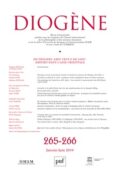Étiquette : Chine
-

The CCP’s 100-year trajectory through the prism of its founding principles
Organization, ideology, social bases, modernization and nation-building agenda June 24-25-26, 2021 Organizers: Inalco, French Research Institute on East Asia (IFRAE), the European Institute for Chinese Studies (EURICS) and the Oxford School of Global and Area Studies (OSGA).With the support of the French Academic Network on Asian Studies (GIS Asie) Scientific coordination: Chloé Froissart (IFRAE, Inalco),…
-
Pensée tibétaine et métaphysique analytique : Moi, identité, personne
Stéphane Arguillère (IFRAE) et Frédéric Nef (EHESS) lancent un séminaire de philosophie comparée : Pensée tibétaine et métaphysique analytique, consacré cette année au thème suivant : Moi, identité, personne. Dates Les séances auront lieu le jeudi de 15h à 17h, aux dates suivantes : 18/03 ; 25/03 ; 01/04 ; 08/04 ; 15/04 ; 06/05.Salle : LO.02 , 2 rue de Lille, Paris 7ème (ou: https://zoom.us/j/98237579739) Contact :…
-
中国与韩国新儒学视野下“道统”的建立与诠释 (Constructing and Interpreting the Daotong in the Perspective of Chinese and Korean Neo-Confucianism)
Frédéric Wang, rédacteur invité, Zhedong xueshu 浙東學術 (dir. Dong Ping 董平), n°4, 中国与韩国新儒学视野下“道统”的建立与诠释 (Constructing and Interpreting the Daotong in the Perspective of Chinese and Korean Neo-Confucianism), 2020. La revue a repris les actes d’un colloque international « Constructing and Interpreting the Daotong (Transmission of the Way) in the Perspective of Chinese and Korean Neo-Confucianism », coorganisé avec l’Inalco (Frédéric Wang, IFRAE),…
-

De proches amis venus de loin: amitiés dans l’Asie orientale
→ La revue en ligne Il faut, entend-on dire souvent de parents inquiets, bien choisir ses amis. Et l’on comprend par là, dans un savoir d’expérience qui s’est imposé aux aînés et qu’ils ont eux-mêmes appris de leur père et de leur mère, qu’il faut éviter les « mauvaises fréquentations », délétères, corruptrices et qui font irrémédiablement dévier…
-
Conflicting Memories
→ Le livre chez l’éditeur Barnett, R., Weiner, B., & Robin, F. (Eds.). (2020). Conflicting Memories. Leiden, Nederland: Brill. Conflicting Memories is a study of how the Tibetan encounter with the Chinese state during the Maoist era has been recalled and reimagined by Chinese and Tibetan authors and artists since the late 1970s. Written by a team…
-

Reclaiming the Wilderness, Contemporary Dynamics of the Yiguandao
→ Le livre chez l’éditeur Sébastien Billoud, Reclaiming the Wilderness, Contemporary Dynamics of the Yiguandao, Oxford University Press, Oxford, 2020, 312 p. A syncretistic and millenarian religious movement, the Yiguandao (Way of Pervading Unity) was one of the major redemptive societies of Republican China. It developed extremely rapidly in the 1930s and the 1940s, attracting millions…
-

Toutes les dates du 12e mois lunaire et du 1er mois lunaire sont des jours fastes
→ L’article en ligne Renyou Hou, « « Toutes les dates du 12e mois lunaire et du 1er mois lunaire sont des jours fastes » », Temporalités [En ligne], 30 | 2019, mis en ligne le 23 juillet 2020 Le mariage est l’un des rites les plus importants du cycle de vie dans la société chinoise. Le choix de la date des noces est rarement fait à la légère,…
-
Covid-19: relation Europe-Chine
Le 29 avril 2020, Andreea Budeanu, doctorante, était invitée dans l’émission Géopolitique, le débat, sur la radio RFI. → suivez ce lien pour écouter son intervention sur les relations Europe-Chine à la lumière de la crise liée au coronavirus.
-

Musique et hiérarchie sociale en Chine contemporaine
→ L’article dans la revue CAPDEVILLE-ZENG Catherine, « Musique et hiérarchie sociale en Chine contemporaine », L’ethnographie, 2 | 2020, mis en ligne le 20 mars 2020
-
Peinture chinoise “Banana Plant”
C’est dans le cadre du cours sur la peinture chinoise assuré par André Kneib, que se tient la conférence du 15 février 2018 dans l’auditorium.